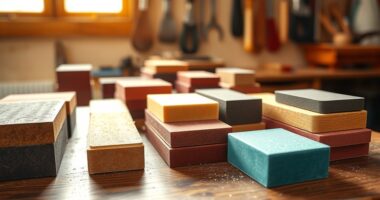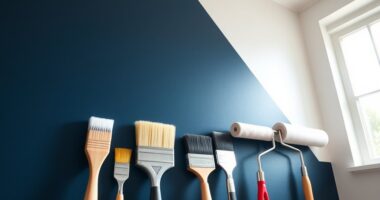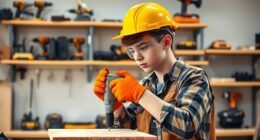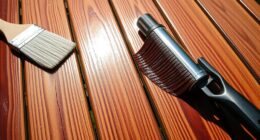When I tackled my flooring project, I found DAP 59184, Henry 12064, and CUSTOM BLDG PRODUCTS 21018 to be high-quality floor leveling compounds. Each offers unique benefits like quick drying and easy application, making them perfect for DIY enthusiasts. I also liked SIKA’s primer for self-leveling and SAVOGRAN for versatile use. These compounds guarantee a smooth finish, and if you’re curious about more options and their specific advantages, you’ll uncover some great insights ahead.
Key Takeaways
- Choose compounds like DAP 59184 for old wood underlayment or Henry 12064 for versatile applications on plywood and concrete surfaces.
- Consider fast-drying options like CUSTOM BLDG PRODUCTS 21018 for quick project completion without sacrificing adhesion.
- Use SIKA Sikalevel for easy application and low odor, ensuring a smooth finish when preparing for self-leveling underlayment.
- Look for flexible compounds such as DAP GIDDS-1030404 to accommodate substrate movement and minimize cracking over time.
- Evaluate coverage area efficiency to reduce labor and material costs, with some compounds covering up to 16 square feet per quart at 1/8 inch depth.
DAP 59184 QT RTU FLR Leveler, 32 oz, Light Gray

If you’re tackling uneven surfaces before laying down new flooring, the DAP 59184 QT RTU FLR Leveler is a solid choice. I found it ideal for filling and leveling spots on old wood underlayment. The light gray color blends well with various flooring types. While I applied it with a putty knife, I noticed the consistency is thick, making it a bit tricky to spread. It took longer to dry than expected, but it’s durable and resistant to cracking. Just keep in mind it’s not perfect for achieving a smooth surface, so plan accordingly for your project.
Best For: Homeowners or DIY enthusiasts looking to level uneven surfaces before installing new flooring like carpeting or vinyl.
Pros:
- Durable and resistant to cracking, ensuring long-lasting performance.
- Effective for filling and leveling old wood floor underlayment.
- Light gray color blends well with various flooring options.
Cons:
- Thick consistency can make application challenging and time-consuming.
- Takes longer to dry than indicated on the packaging.
- Not ideal for achieving a perfectly smooth surface; primarily for leveling purposes.
Henry 12064 Gallon Pre-Mixed Floor Patch

Henry 12064 Gallon Pre-Mixed Floor Patch is an ideal choice for DIY enthusiasts and professionals looking for a hassle-free solution to floor leveling. I love that it comes premixed, making it super easy to work with. You can spread it effortlessly across various surfaces like plywood and concrete, filling gaps and repairing cracks. Users often praise its performance, especially for vinyl plank flooring. Just remember, it takes about 24 hours to harden, but some suggest allowing longer for the best results. Overall, I’ve found it reliable, with only minor concerns about texture and drying.
Best For: DIY enthusiasts and professionals seeking a convenient and effective solution for floor leveling and repair.
Pros:
- Easy to use premixed formula, eliminating the need for mixing powders.
- Versatile application on various surfaces, including plywood and concrete.
- Provides a solid base for further flooring installations after drying.
Cons:
- Some users report issues with uneven drying and texture.
- Delivery delays and damaged packaging have been noted by customers.
- Longer curing times may be required for optimal results.
21018 Floor-Leveling-compounds

For those tackling uneven flooring, the CUSTOM BLDG PRODUCTS 21018 Floor-Leveling Compounds stands out as an excellent choice, thanks to its fast-drying formula. Weighing 50 pounds, this gray compound effectively levels floors and prepares surfaces. I’ve found it easy to mix, and many users report great adhesion for tiles. Just remember to clean the area and apply a primer first. Mixing with a bit more water can improve flow, and using a squeegee helps achieve a smooth finish. While some experienced issues with hardening, following the instructions closely can lead to a flawless outcome.
Best For: Homeowners and DIY enthusiasts looking to effectively level uneven floors quickly and easily.
Pros:
- Fast-drying formula allows for quick application and reduced downtime.
- Good adhesion for tiles, making it suitable for a variety of flooring projects.
- Easy to mix and apply, providing a smooth finish with the right technique.
Cons:
- Can harden prematurely if not mixed and applied according to instructions.
- Users recommend using a primer to prevent water absorption, adding an extra step to the process.
- Some users experienced issues with flow and leveling if not mixed with slightly more water than recommended.
SIKA Sikalevel Self-Leveling Underlayment Primer – 1 Gallon
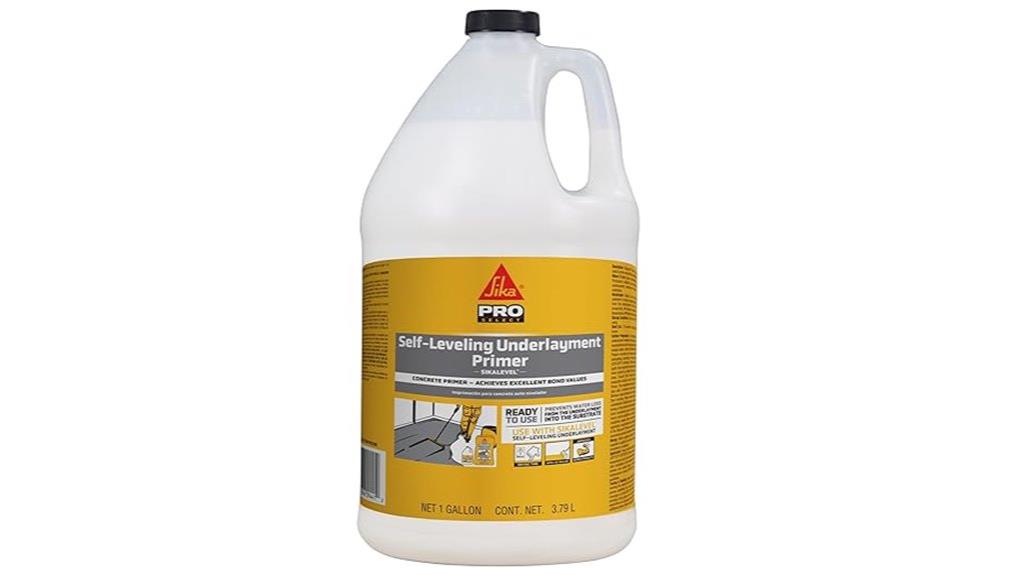
SIKA Sikalevel Self-Leveling Underlayment Primer – 1 Gallon is an excellent choice for DIY enthusiasts and professionals alike who need a reliable solution for preparing floors. This one-part, water-dispersed primer is ready to use without dilution, specifically designed for Sika Self-Leveling Underlayment. It seals absorbent substrates like concrete, preventing water loss and guaranteeing a strong bond. I love how easy it is to apply—just roll it on, and it’s typically ready for self-leveler in about two hours. With low odor and great coverage, it’s perfect for larger projects. Just verify your substrate is dry for the best results!
Best For: DIY enthusiasts and professionals looking for an efficient and effective self-leveling primer solution for floors.
Pros:
- Easy to apply with a roller and quick drying time, typically ready for self-leveling in about two hours.
- Seals absorbent substrates effectively, preventing water loss and ensuring strong bond values.
- Low odor during application makes it suitable for indoor use in larger projects.
Cons:
- Some users experienced flaking issues with the leveler in specific areas, highlighting the need for proper application.
- Requires a dry and porous substrate for optimal results, which may necessitate additional preparation.
- Coverage area may vary based on substrate conditions, potentially leading to unexpected additional purchases.
SAVOGRAN 12832 4-1/2LB FLR Leveler, 4-1/2 lb, White to Off-White

If you’re tackling a flooring project and need a reliable solution for leveling surfaces, the SAVOGRAN 12832 Floor Leveler could be your go-to choice. Weighing in at 4.5 pounds, it’s perfect for leveling and repairing concrete and wood floors before installing linoleum, tile, or carpeting. I found it easy to use and highly durable, making it a great addition to my flooring toolkit. However, keep in mind it’s not suitable for basements or below-grade applications. With a decent rating of 3.8 stars, customers have varied experiences, so be sure to follow the mixing ratios for the best results.
Best For: Homeowners and DIY enthusiasts looking for an effective solution to level and repair floor surfaces before flooring installation.
Pros:
- Easy to use: Simplifies the process of leveling floors, making it accessible for users of all skill levels.
- Durable: Provides long-lasting results, ensuring a solid foundation for new flooring.
- Versatile: Suitable for various surfaces, including concrete and wood, making it a practical choice for different projects.
Cons:
- Not suitable for basements: Limited to above-grade applications, which may restrict its use in certain areas.
- Varied customer experiences: Some users report issues with mixing ratios and application, leading to inconsistent results.
- Average rating: With a 3.8-star rating, some customers may have reservations based on mixed feedback.
Akona Self-Leveling Floor Underlayment (50 Pound)

Akona Self-Leveling Floor Underlayment is an excellent choice for DIY enthusiasts and professional contractors looking to achieve a smooth, even surface for various flooring types. Its self-leveling technology flows freely, ensuring a flawless finish on vinyl, tile, hardwood, and more. I love how fast-drying it is—walkable in just 3-4 hours! This versatile underlayment works well over ceramic, concrete, and even wood, accommodating thicknesses from ⅛ to 5 inches. With a strength of up to 5,500 psi after 28 days, it provides a solid foundation and has garnered positive feedback for its ease of use and effectiveness.
Best For: DIY enthusiasts and professional contractors seeking a fast-drying, easy-to-use underlayment for a variety of flooring types.
Pros:
- Self-leveling technology ensures a smooth and even surface.
- Fast-drying, allowing for foot traffic in just 3-4 hours.
- High strength of up to 5,500 psi after 28 days provides a durable foundation.
Cons:
- May require proper surface preparation for optimal results.
- Limited to specific thickness ranges (⅛ to 5 inches).
- Potentially higher cost compared to traditional underlayment options.
DAP 20369 10414 concretes, No Size, Gray

For those tackling concrete floor leveling projects, DAP 20369 10414 stands out as an ideal choice. This 5-pound gray concrete floor leveler is perfect for patching and leveling areas like garages and kitchens. I appreciate that it dries within 12-24 hours, allowing for quick project completion. Just mix it with a bonding adhesive additive and apply in thin lifts to prevent cracking. While it boasts a solid 4.3-star rating, I’ve noticed mixed reviews regarding its size and application. Overall, it’s a reliable option for achieving a smooth finish, especially when used correctly.
Best For: Homeowners and DIY enthusiasts looking to patch and level concrete floors in garages and kitchens.
Pros:
- Quick Drying Time: Dries within 12-24 hours, allowing for efficient project turnaround.
- Effective Performance: Designed for successful leveling and patching when used with a bonding adhesive additive.
- Reliable Quality: Holds a solid 4.3-star rating from users, indicating general satisfaction.
Cons:
- Mixed User Reviews: Some users report issues with product size and application difficulties.
- Requires Adhesive Additive: Needs to be mixed with a bonding adhesive, which may add to project complexity.
- Limited Coverage: The 5-pound package may not be sufficient for larger areas, requiring multiple purchases.
Ardex Feather Finish Grey/Gray/Gris Self-Drying Cement Based Bag 10 Lbs

Ardex Feather Finish Grey/Gray/Gris is an exceptional choice for DIY enthusiasts and professionals looking to achieve a smooth, durable surface on various flooring types. This 10 lbs self-drying cement-based underlayment mixes easily with water and offers a trowelable consistency. I found it perfect for encapsulating cutback residue and creating a flawless finish on my mobile home’s fireplace surround. Just remember to wet mop the surface before applying and use a 12-inch flat trowel for best results. After a year, my project still looks great, proving its long-term performance. Just follow the instructions for a successful application!
Best For: DIY enthusiasts and professionals seeking a smooth, durable underlayment for various flooring surfaces.
Pros:
- Easy to mix and apply: Just add water for a trowelable consistency.
- Versatile usage: Suitable for multiple surfaces, including concrete, wood, and tile, without the need for priming.
- Long-lasting performance: Maintains integrity and appearance over time, even in challenging conditions.
Cons:
- Requires careful application: Must wet mop the surface and use the right tools for optimal results.
- Color variations: Differences in color between batches may necessitate adjustments in colorants.
- Mixing limitations: Dries quickly, so only mix what can be worked with to avoid waste.
DAP GIDDS-1030404 1 gallon Light Grey Flexible Floor Patch & Leveler

If you’re tackling a flooring project and need a reliable solution for filling cracks and leveling surfaces, the DAP GIDDS-1030404 1 Gallon Light Grey Flexible Floor Patch & Leveler is an excellent choice. This latex-based, ready-to-use compound easily fills fastener holes and levels low areas in both plywood and concrete. It’s water-resistant and remains flexible, accommodating subfloor movements without cracking. I appreciate its versatility, as it works indoors and outdoors, though it may require multiple layers for larger areas. With a drying time that can stretch up to 18 hours, patience is key. Overall, it’s a solid option for your flooring needs.
Best For: Homeowners and DIY enthusiasts seeking an effective solution for filling and leveling surfaces prior to flooring installation.
Pros:
- Versatile Application: Suitable for both plywood and concrete surfaces, and can be used indoors and outdoors.
- Flexible Formula: Remains flexible after application, allowing for subfloor movement without cracking.
- Water-Resistant: Provides durability and is ideal for areas that may encounter moisture.
Cons:
- Longer Drying Time: May take up to 18 hours to dry, especially in high humidity conditions.
- Potential Shrinkage: Some users report shrinkage requiring additional layers for larger areas.
- Sanding Limitations: Although paintable, the product may not sand well after drying.
Savogran 12832 4-1/2LB FLR Leveler, 4-1/2 lb, White to Off-White

Savogran 12832 FLR Leveler stands out as an excellent choice for DIY enthusiasts and professionals alike who need a reliable solution for leveling floors. Weighing in at 4-1/2 lbs, it’s incredibly easy to use and offers impressive durability. The color ranges from white to off-white, blending well with various surfaces. With a customer rating of 5.0 out of 5 stars, it’s clear that others have had great success with this product too. Whether you’re tackling a small patch or a larger project, this leveler is a solid option that won’t disappoint. Give it a try for your next flooring project!
Best For: DIY enthusiasts and professionals looking for a reliable and easy-to-use floor leveling solution.
Pros:
- Highly durable, ensuring long-lasting performance.
- Very easy to use, making it suitable for users of all skill levels.
- Excellent customer rating of 5.0 out of 5 stars, indicating high satisfaction.
Cons:
- Limited availability with a Best Sellers Rank of #869,846 in Tools & Home Improvement.
- Only suitable for floor leveling, which may limit its versatility for other projects.
- Relatively lightweight at 4-1/2 lbs, which might not be ideal for larger jobs requiring heavier materials.
DAP Bonding Liquid Floor Leveling Additive (1 Pint)
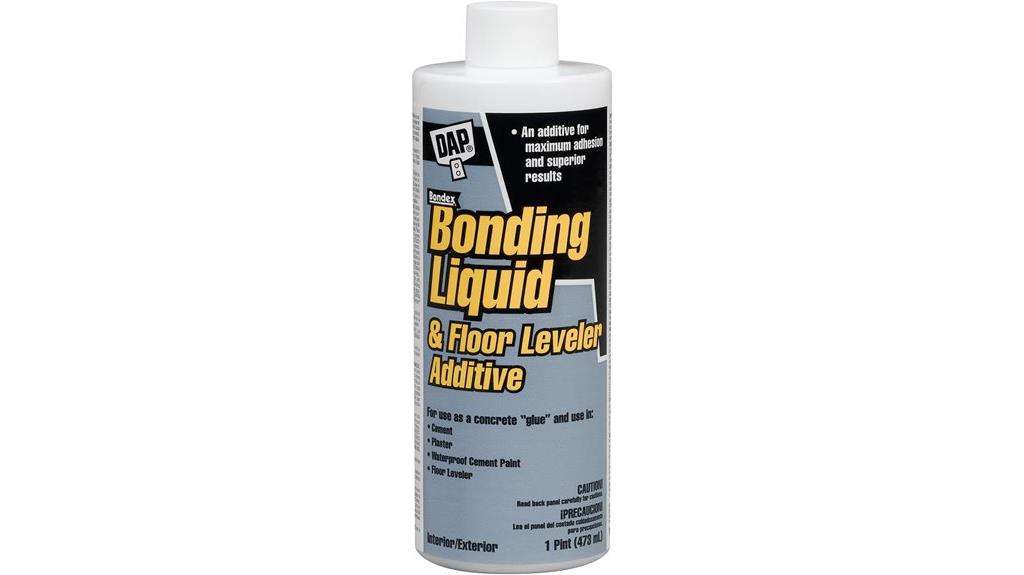
For DIY enthusiasts and professional contractors alike, the DAP Bonding Liquid Floor Leveling Additive is an essential tool in achieving a strong and durable finish. This 1-pint additive enhances the adhesion and flexibility of concrete, mortar, and plaster, making it perfect for various applications both indoors and outdoors. Weighing just 1 pound, it’s easy to work with, though I’ve noticed some users report separation issues that can complicate mixing. Despite this, its solid customer rating of 4.2 out of 5 stars reflects its reliability. Plus, with a 30-day return policy, it’s a low-risk addition to your toolkit.
Best For: DIY enthusiasts and professional contractors looking for a reliable additive to enhance the adhesion and flexibility of concrete and plaster.
Pros:
- Enhances adhesion and flexibility in various applications, improving overall durability.
- Suitable for indoor and outdoor use, making it versatile for different projects.
- Easy to use with a manageable size of 1 pint, ideal for smaller jobs.
Cons:
- Reported separation issues can complicate the mixing process, leading to wasted materials.
- Moderate customer rating of 4.2 out of 5 stars indicates some variability in user satisfaction.
- Best Sellers Rank suggests it may not be the most popular choice among similar products.
DGSL Tile Leveling System with Tile Plier (300-Piece Tile Spacers Clips & 100-Piece Wedges)
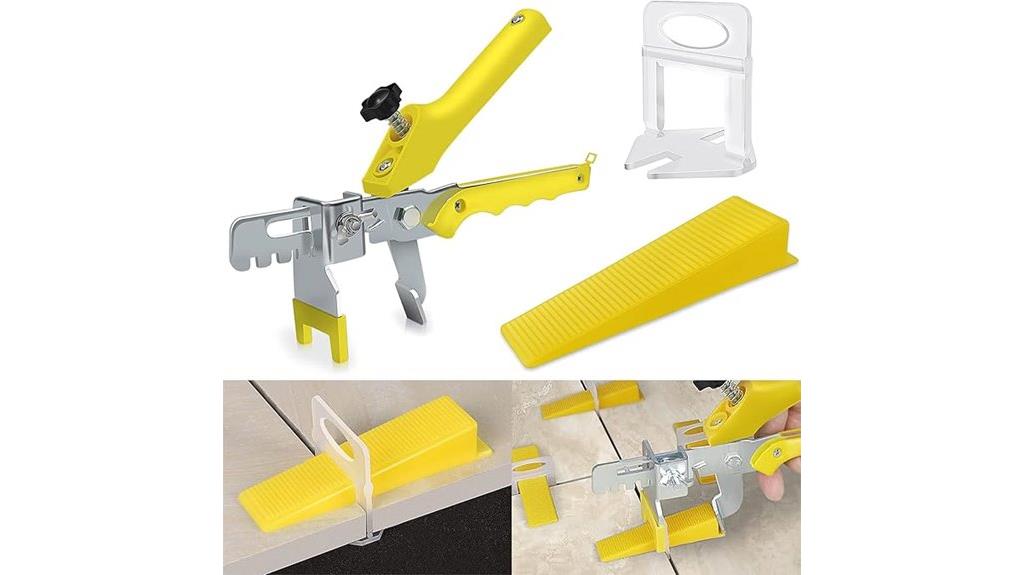
The DGSL Tile Leveling System stands out as the best choice for both DIY enthusiasts and professional tile layers seeking a reliable solution for achieving perfectly level tiles. With 300 tile spacers and 100 reusable wedges, this system makes installation efficient and straightforward. I love how the included tile plier helps clamp everything into place, ensuring a lippage-free finish. Plus, it’s designed for tiles ranging from 1/8 to 1/2 inch thick, which suits my projects perfectly. Users rave about its ease of use and effectiveness, making it a smart investment for anyone looking to achieve a flawless tile surface.
Best For: The DGSL Tile Leveling System is best for DIY enthusiasts and professional tile layers seeking a reliable method for achieving perfectly level tiles.
Pros:
- Easy to use and efficient for both DIY and professional applications.
- Includes reusable wedges and a tile plier for quick clamping and a lippage-free finish.
- Highly rated by users for its cost-effectiveness compared to other brands.
Cons:
- Some spacers may not break off cleanly, requiring additional effort for removal.
- Users recommend using a rubber mallet for better removal of spacers.
- Excess thinset around clips can complicate the leveling process.
Clear Floor Epoxy Resin Kit (1.5 Gallon)

If you’re looking to transform your dull concrete surfaces into something attractive and durable, the Clear Floor Epoxy Resin Kit (1.5 Gallon) is an excellent choice. This kit covers 225-300 sq.ft., making it perfect for garages, basements, or industrial areas. I appreciate its resistance to scratches and stains, ensuring a long-lasting finish. The glossy look enhances any space, and you can customize it with color pigments. Application is straightforward with proper prep, though I recommend sealing with two coats for the best results. Overall, it’s a fantastic option for achieving a stunning, easy-to-maintain surface that withstands heavy traffic.
Best For: Homeowners and businesses looking to enhance the appearance and durability of concrete surfaces in garages, basements, and commercial spaces.
Pros:
- Highly durable and resistant to scratches, stains, and spills.
- Customizable with color pigments for a high-gloss finish.
- Easy maintenance due to its non-porous, seamless design.
Cons:
- Some users may experience issues with product consistency and coverage.
- Requires proper preparation to avoid air bubbles and applicator marks.
- Mixed experiences with customer service regarding product contamination or delivery.
Pro-Grade 1/8 Professional Tile Leveling System Kit (700 Base + 100 Caps)

Engineered for DIY enthusiasts and professionals alike, the Pro-Grade 1/8 Professional Tile Leveling System Kit stands out with its precision features and user-friendly design. With 700 bases and 100 caps, it allows for effortless installation and guarantees precise 1/8 spacing. I love the Zero Lippage Technology, which eliminates height differences, assuring a flawless finish. Installation is a breeze—pre-assembled clips let me set up 40 tiles an hour, vastly reducing project time. Plus, the color-coded system minimizes errors. Weighing only 4.09 pounds, it’s lightweight yet robust, making my tiling projects smoother and faster than ever.
Best For: DIY enthusiasts and professionals seeking efficient and precise tile installation.
Pros:
- Precision 1/8 spacing with laser-calibrated wedges ensures exact grout lines.
- Zero Lippage Technology effectively eliminates tile height differences for seamless finishes.
- Lightweight design allows for quick setup, achieving 40 tiles/hour and reducing project time significantly.
Cons:
- Limited to specific tile thicknesses due to the 1/8 size specification.
- Only includes 100 caps, which may not be sufficient for larger projects without additional purchases.
- Requires manual installation, which may not suit those looking for automated solutions.
Work Spiked Shoes for Epoxy Floor Coating

For professionals tackling epoxy floor coatings, the Nivilli WORK spiked shoes are a game changer. These lightweight clogs make walking on leveling compounds and liquid sealants a breeze. I love how easy they are to slip on and off, plus they’re made from dirt-resistant PU material. The steel nails provide excellent balance and prevent sticking, which helps eliminate air bubbles during application. With an extra support strap, they fit securely and comfortably. After using them on over 100 projects, I can confidently recommend these shoes for their stability, protection, and ease of cleaning. They truly enhance the installation experience!
Best For: Professionals and DIY enthusiasts working on epoxy floor coatings and other leveling compounds who value stability and ease of use.
Pros:
- Lightweight and easy to clean, made from dirt-resistant PU material.
- Excellent balance and stability provided by the steel nails, preventing sticking and air bubbles.
- Comfortable slip-on design with an extra support strap for a secure fit.
Cons:
- May not be suitable for use on uneven surfaces without additional support.
- Limited color options available.
- Some users may find the sizing tricky if they are between sizes.
Factors to Consider When Choosing Floor Leveling Compounds
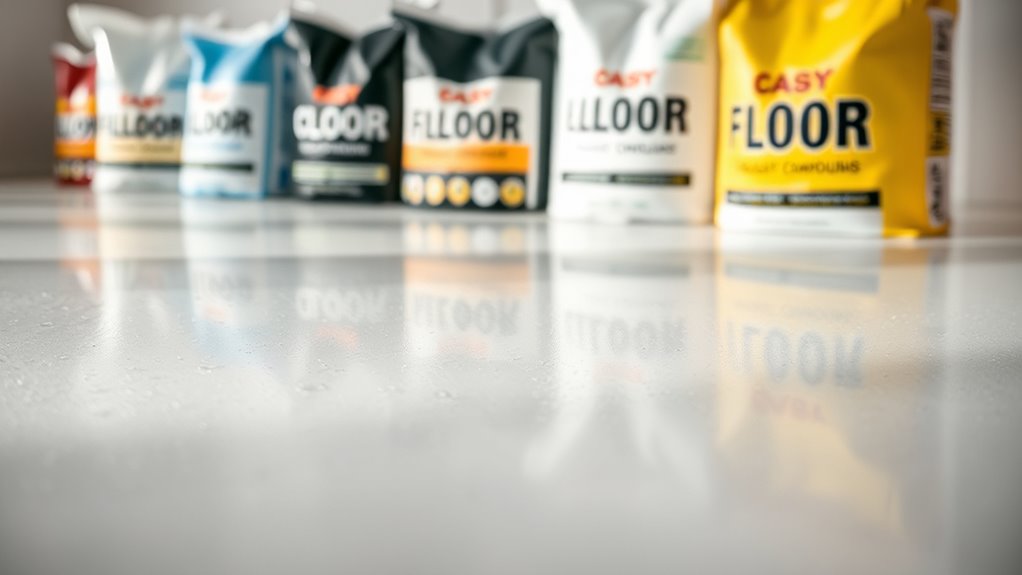
When I’m choosing a floor leveling compound, I always think about a few key factors. Surface compatibility, drying time, and application methods can really impact my project’s success. I want to make certain I pick a product that offers the right flexibility, durability, and coverage for my needs.
Surface Compatibility Requirements
Choosing the right floor leveling compound requires careful consideration of surface compatibility, as the wrong product can lead to poor adhesion and performance. Different compounds are formulated for specific surfaces like concrete, wood, or tile, so it’s vital to match the product to your substrate. Some compounds work well on absorbent surfaces, while others suit non-porous materials, which is essential for effective application. Additionally, consider the thickness required; some compounds can level low spots several inches deep, while others are best for thin applications. Always check the manufacturer’s guidelines regarding surface preparation, including moisture content and cleanliness, as these factors greatly impact the compound’s effectiveness. Making informed choices here will set the foundation for a successful leveling project.
Drying Time Considerations
Understanding drying time is vital in your selection of floor leveling compounds, as it can greatly impact the overall success of your flooring project. Drying times can vary widely, often ranging from 12 to 48 hours, influenced by environmental conditions like humidity and temperature. While manufacturers provide specific drying times, I’ve found that actual performance may differ, so it’s wise to expect longer drying periods than stated. Allowing adequate time for the compound to fully cure is essential to avoid issues with cracking or shifting under weight. Additionally, if multiple thin applications are needed for a smooth finish, this will extend your project timeline. Planning for these factors can save you headaches and guarantee a flawless installation.
Application Method Preferences
After accounting for drying times, the method of application becomes a key factor in selecting the right floor leveling compound. I’ve found that premixed options are generally easier to work with than powdered mixes, which require preparation. When applying the compound, tools like putty knives, trowels, and squeegees can greatly influence the finish quality. The viscosity matters too; thicker compounds demand more effort to spread evenly, while fluid mixtures tend to self-level. Some compounds allow for adjustments during application, but be cautious—if they set quickly, you’ll have less time to smooth and level. Finally, ensuring proper surface preparation and following mixing ratios is essential for avoiding issues like cracking and uneven drying.
Flexibility and Durability
When considering floor leveling compounds, flexibility and durability are vital factors that can’t be overlooked. I’ve found that a flexible compound can adapt to the natural movement of the substrate, considerably reducing the risk of cracking over time. It’s important to choose a product that maintains its flexibility after curing, especially in environments with temperature fluctuations. Durability is equally important; compounds need to withstand heavy foot traffic and resist stress from humidity changes. A compound that resists cracking and separation after drying will guarantee long-term performance. Striking the right balance between flexibility and durability means you can trust your flooring to hold up under various conditions, giving you peace of mind for years to come.
Coverage Area Efficiency
Choosing the right floor leveling compound can greatly impact the efficiency of your project, especially regarding coverage area. I always consider how much area the product covers per unit; some compounds manage around 12-16 square feet at a depth of 1/8 inch per quart. Efficient compounds cut down on labor and material costs by requiring fewer applications to achieve the desired thickness. I also pay attention to drying times, as compounds that take longer to cure can delay the project. Fast-drying options that allow for quick walkability within 3-24 hours are ideal. Finally, I assess the thickness range achievable per application, ensuring it suits my floor’s condition to optimize material usage.
Frequently Asked Questions
How Long Does It Take for Floor Leveling Compounds to Cure?
When I’m working with floor leveling compounds, I often wonder how long they take to cure. Typically, it’s around 24 to 48 hours, but I’ve learned that full strength might take up to a week. I always make certain to check the manufacturer’s instructions, as different products can vary. Patience is key, though, because waiting guarantees a solid base for my flooring. I recommend giving it ample time before moving on.
Can I Use Floor Leveling Compounds on Exterior Surfaces?
I’ve often wondered if I can use floor leveling compounds on exterior surfaces, and the answer is yes, but with caution. Some compounds are specifically designed for outdoor use, providing durability against weather elements. However, I always check the manufacturer’s guidelines to guarantee proper application. It’s vital to choose a product that can withstand temperature fluctuations and moisture, so my exterior surfaces stay level and intact over time.
What Is the Best Way to Apply Floor Leveling Compounds?
Applying floor leveling compounds feels like painting a blank canvas; it’s all about technique. First, I prepare the surface, ensuring it’s clean and free of debris. Next, I mix the compound according to instructions, achieving a smooth consistency. Using a trowel, I spread it evenly, working from one corner to another. I make sure to feather the edges for a seamless finish. Patience and precision turn my messy floor into a masterpiece!
Are Floor Leveling Compounds Waterproof or Moisture-Resistant?
I’ve often wondered about the moisture resistance of floor leveling compounds. Generally, most compounds aren’t completely waterproof, but many do offer some level of moisture resistance. It’s essential to check the product specifications before applying. I’ve found that using a moisture barrier beneath the compound can enhance protection against water damage. If you’re working in damp areas, investing in a high-quality moisture-resistant compound can make a significant difference in durability.
Can I Paint Over Floor Leveling Compounds After Curing?
I’ve often wondered if I could paint over floor leveling compounds after they’ve cured. The good news is, you absolutely can! Once the compound has fully dried and cured, it provides a solid surface for paint. Just make sure to clean the area thoroughly and consider a primer for the best adhesion. I’ve found that this creates a smooth, even finish that enhances both the look and durability of the floor.
Conclusion
In my search for the perfect floor leveling compound, I stumbled upon options that not only promise a smooth finish but also tackle unique challenges. It’s funny how a simple choice can transform your space! Whether you’re a DIY enthusiast or a seasoned pro, the right product makes all the difference. So, as you embark on your project, remember these recommendations; they just might be the coincidence that leads you to a flawless floor you’ll love for years to come!




